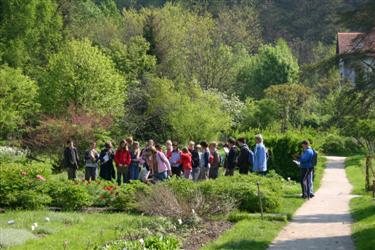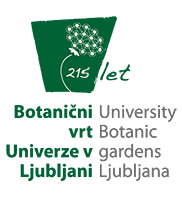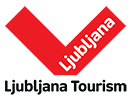
1. General tour of Botanic Garden in different seasons
2. Structure, growth and development of plants
(1) Plant propagation – seeds and cuttings
(2) Plant organs
3. Habitats
(1) Puddle, marsh and bog
(2) Carnivorous plants
(3) Meadow and meadow plants
(4) Create a plant that…
(5) Forest and woody plants
(6) Trees during winter
(7) Tropical glasshouse – plants of tropical and subtropical sites and adjustments to their environment
4. Plant system
(1) How to determine plants?
5. Plants, their use and inportance for humans
(1) Plants and Festivals: Pumpkin the Pumpkin and the Halloween
6. Magnifiers (only for 5th grade)
(1) Seeds
(2) Plant organs
(3) Puddle
7. Plant detectives – individual work
8. Excursion to Ljubljana Moors
- General tour of Botanic Garden in different seasons
We take a look at all parts of the Botanic Garden: Arboretum, Rockery, Tropical glasshouse, Wetlands, Plant system... and learn about tipical plants, their characteristics, habitats... The Botanic Garden is more than just an interesting park. In the very center of Ljubljana, you can observe the endagered, rare or nearly extinct plants, see plants from all parts of Slovenia and from other parts of the World, you see animals who have found refuge in similar conditions as in nature. Every season shows a different picture of the plant kingdom.
Performed throught the year. - Structure, growth and development of plants
On live plants pupils learne what are adventitious roots or which forma of leaves we differentiate. They can observe flower structure and all parts of flower, that are necessary for reproduction or recognize the importance of forms of fruit for their vectors.
(1) Plant propagation – seeds and cuttings
Who would not want to observe the development of plants from seed on? When we open delicious orange, sour lemon, big grapefruit and found the seeds in them, we plant them carefully. While planting we discuss what seeds and plants need to grow, what is a proper way to plant them and how to take care for them, how will a new plant grow from the seed. Instead of planting seeds into ordinary pots, we can make a real sprouters so that every day we can take a look if our seed has sprouted yet. We also learn about special plants that do not need seeds for propagation and what are the cuttings.
Instead of seeds, you can select a young plant with roots and transplate it into your pot and take it home with you.
You can combinate this workshop with the themes General tour, Meadow and meadow plants, Honey plants and pollinators, Plant organs, Tropical glasshouse and Plants from hot places and their adaptations.
(2) Plant organs
* Roots, stem, leaf, flower
* Flower – structure nad function
* Workshop Flower
* Soil and roots
* Fruits and dispersal of plants
Plant of our region and from foreign countries are ending growth season with fruit ripening, We will take a look at different fruits, observe and describe their structure, think about possible vectors, distinguish dry and fleshy fruits, learn what is seed, what fruit and what a multiple fruit. At the workshop children make models of linden tree fruit, test which flies best and think by which device man imitated linden tree fruit, or they can create with seeds and fruits: make designs from fruits such as different animals or pictures from seeds. - Habitats
In various parts of the garden, pupils learn about different habitats, which are characterized by unique plants. On meadow and in plant system, they learn about meadow plants in the puddle and in pools they observe aquatic, marsh and bog plants and aquatic animals. In rockery they get to know mountain and karst plants, including many endangered and protected. In Arboretum they learn about native and exotic woody species, ecology of plants in the undergrowth, vines, importance of the forest… They learn the difference between spruce and fir, how to recognize yew, what is the difference between bush and tree… In winter they learn how to distinguish different tree species by characteristies of their bark, growth, winter buds. The Tropical glasshouse offers the possibility of learning about the tropical climate, vegetation, adapations of plants to the ecological conditions in the tropical rain forest.
(1) Puddle, marsh and bog
In late spring the life is awakening in the puddle too. We will hunt animals with nets and take a closer look at them, learn about aquatic, and marsh plants and their adaptation to the environment. The Botanic Garden is located on the outskirts of Ljubljana Moors, where several thousand years ago pile dwellers lived. What is a bog or moor anyway and how it differs from marsh? What plants grow in the moors? How did the Ljubljana Moors develop and what says a legend about the origin of Ljubljana? Will we find plant residues in peat and remains of snails in marlstone? Would you like to know which plants were pile dwellers using for building houses, making clothes and food? At the workshop, pupils create a puddle collage: cut pictures of plants and animals out of paper, adhere them to the ppropriate location on the drawing of the puddle and colour them. For the 5th grade, there is also a possibility of workshop Magnifiers (observation of parts and sections of aquatic, marsh and bog plants).
Performed from May to September.
(2) Carnivorous plants
Carnivorous plants have evolved in environments where is a lack of minerals. Where are such environments? Do carnivorous plants grow in Slovenia? Which famous scientist was experimenting with carnivorous plants? During the tour we will answer all these questions and also learn about other bog plants and found out what are epiphytes. At the workshop we will observe carnivorous plants with magnifiers and create models of carnivorous plants.
Performed throught the year.
(3) Meadow and meadow plants
In summer, the meadow is full of colorful flowers. We will draw a picture of the most beautiful and learn about them. Without the colorful flowers are grasses that are pollinated by wind and were a source of nowday grains for pre-historical people. Have you ever seen how corn grows? What about wheat? Above the colorful flowers, the insects are flying, between the vegetation and in the soil, many organisms are hiding. We compare the diversity of plants in the meadow and in the forest, survival strategies of annuals and perennials, discover how the plants are adapted to grazing and mowing. We talk about the importance of proper maintenance of the meadows for the preservation of flora and fauna and about the problems of fertilizing and mowing with modern machinery.
Performed from May to September.
(4) Create a plant that…
We discuss which habitats we know. How plants survive on seashore? What about in hot, dry desert? How they survive trough winter or fire? We use our imaginations and invent plants that can grow in a puddle, in the mountains, survive a fire… Then we walk through all parts of Botanic Garden: Arboretum, Rockery, Tropical glasshouse, Wetlands, Plant system... and learn about tipical plants, their characteristics, habitats… We find out how real plants, that can survive under the same conditions as the ones we have created, look like.
Performed from April to October.
(5) Forest and woody plants
What is the forest and what is its significance? Are all forests the same? How many trees we recognise when we walk around the forest? Beech, oak, spruce? What about the chestnut, maple and birch? What is the difference between a spruce, serbian spruce and fir? How can we recognize yew? Do we know same tree eccentrics, such as Najevnik linden tree, a tree from the time of dinosaurs, the highest trees in the world? What is the difference betweeen bush and a tree? We wil learn about some of the most well-known tree species: from Slovenia and abrod, compose food chaines and play a game A puzzle of life. At the workshop children make bark prints and determine to which tree they belong to, learn about different cones, determine the age of the tree and look for different parts of the same tree. They can also plant their own tree. In the autumn, they can make prints of different leaves or pictures out of dried leaves.
Performed from April to November.
(6) Trees during winter
Botanic Gardens is interesting even in the winter. We can observe woody plants in an entirely new light: we observe the color of the bark, observe and touch the surface of the bark, observe, compare and scetch growth habit – the shape of a tree, the way how it grows. We observe winter buds, conifers and bushes that flower in winter, such as witch-hazel and wintersweet.
Performed in winter months.
(7) Tropical glasshouse – plants of tropical and subtropical sites and adjustments to their environment
Tropical glasshouse is pleasantly warm, the plants abundantly grow and remind us of the summer. We will see plants from South America, Asia, Australia and Africa, among others tasty vannilla, spicy ginger, peanuts, further on plants from the time of dinosaurs, papyrus, find out which leaves were people using as book pointers, look for plants in which tropical tree frogs lay their frogspawns and test which characteristics are necessary that the water drains out of the leaf. We will talk about tropical climate, take a look at various adaptations of tropical plants and learn about carnivorous plants.
The Tropical glasshouse is attractive all year round, so you can visit it anytime. - Plant system
In combination with general tour, learning about plant organs, forest or meadow, pupils can observe differences between monocotyledonous and dicotyledonous plants, gymnosperms and angiosperms or determine plants with the simplified Identifying keys.
(1) How to determine plants (using simplified Idetifying keys) - Plants, their use and importance for humans
(1) Plants and Festivals: Pumpkin the Pumpkin and the Halloween
In late autumn, we take a look at different pumpkins, learn how they say pumpkin in various parts of the world, we discuss about Celtic New Year and Halloween and make a ghost, bat spider, which or pumpkin, carv jack-o'-lanterns or decorate lanterns made out of jars.
Performed in October. - Magnifiers (only for 5th grade)
As a suplement to some lessons, offered in Botanic Garden, the use of monoocular magnifiers, is now also available. With the help of magnifiers, pupils can get to know with a miniature world of plants that can not be seen by the naked eye; they can observe the inside of the blossom, parts of the blossom, and other plant organs. They can also admire the diversity in form of seeds and other concealed structures in different parts of a plant.
(1) Seeds
(2) Plant organs
(3) Puddle - Plant detectives – individual work
Pupils get a worksheet that has a map of the garden with marked research stations on one side and drawing of a daisy with research tasks on the other. In small froups they walk around the garden using map and try to solve the tasks: observe or smell the plants, stick leaves, do the experiment, draw, look for plants with certain characteristics… and record their findings. Such a worksheet is an excellent orientation and research tool that encourages orientation on the fild, observing, sketching…
Suitable for 1-hour tour. For 2- or 3-hour tour only in combination with different themes. - Excursion to Ljubljana Moors
We briefly present the Botanic Garden, where we particulary focus on bog plants, that have become practically extincted in the Ljubljana Moors. On the Moors we visite the remains of peat bog Mali Plac, where the marshes and bog vegetation can be seen, and peatlands of Jurč, where we can see the remains of peat and observe the overgrowth. We think about the correctness of certain intervations in this endangered and protected evironments. We observe and learn about the flora and fauna on meadows, fields and in the forest, we learn about the origin and historical development of the Ljubljana Moors, talk about pile dwellers and their culture, flora and fauna in the past and nowdays, think about the reasons for the disappearance of marshes and bogs, and the prospects for their preservation. We also do the experiments with pH. If you decide for an excursion at a time when Snakeshead Lili is in ful bloom, we also visite the wet meadows in villlage Bevke and observe this protected beauty in its natural environment.
Performed from April to September.
(1) Excursion to Ljubljana Moors: visitation of the remains of a peat bog Mali Plac with its typical vegetation and peatlands of Jurč
(2) Bog plants in the Botanic Garden and the excursion to Ljubljana Moors
Excursion is suitable for pupils from 5th to 8th grade. We recommend 3–hour excursion. 4–hour and 5-hour excursion are suitable in combination with the guided tour of the Botanic Garden.
Against additional payment, all themes and workshops can be performed in combination with planting.







